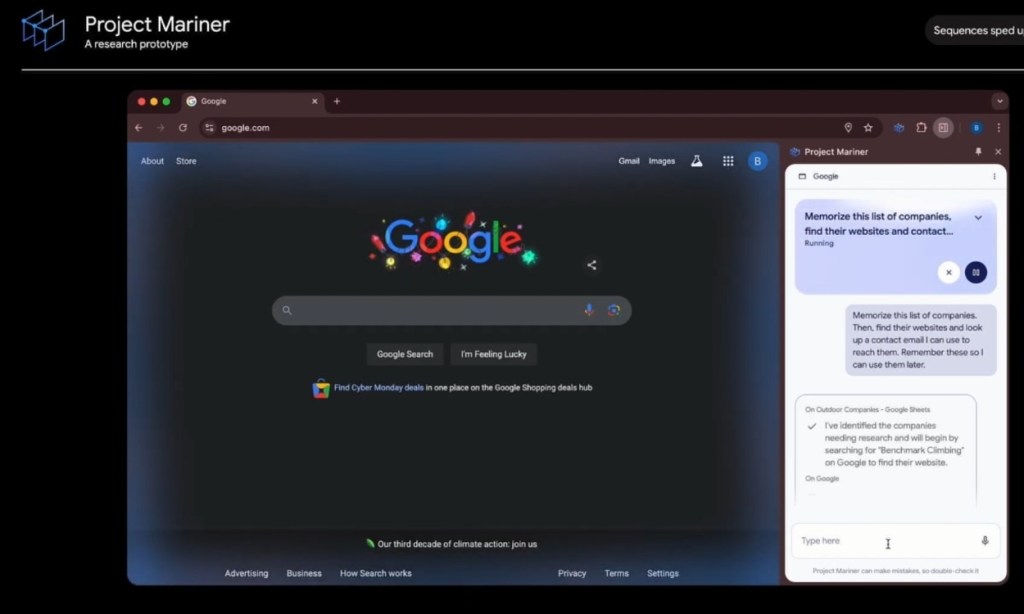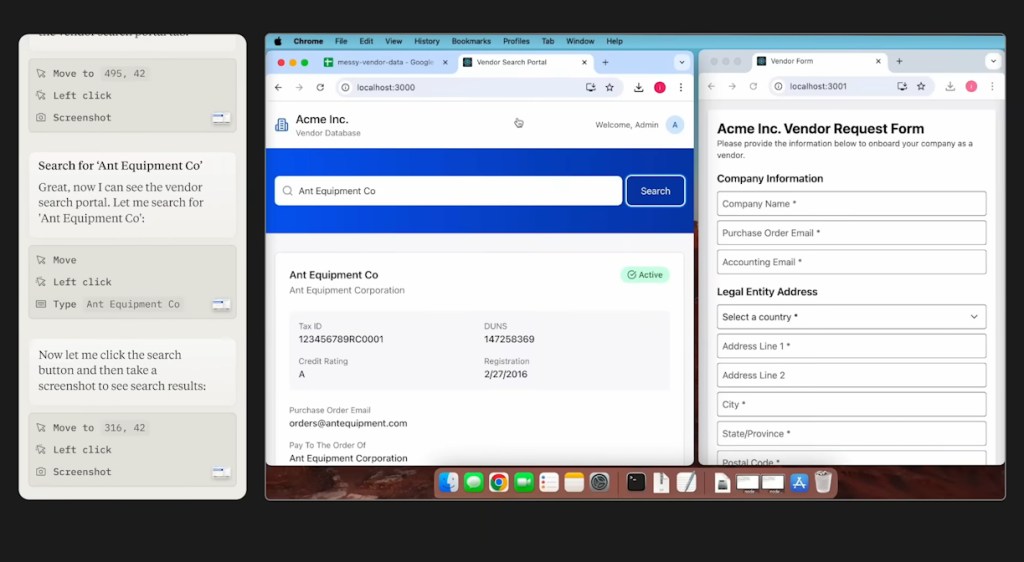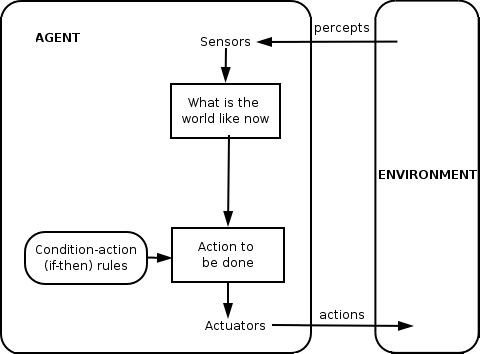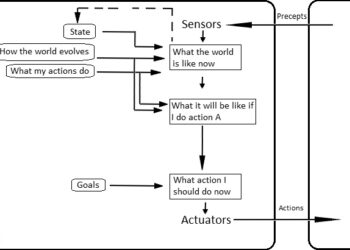It’s clear that action-oriented AI agents are paving the way for the next wave of the AI revolution, and we’re already seeing some promising developments. From AI chatbots to agents that can manage your calendar and emails, we’re entering a new era dominated by these intelligent systems. To help you grasp the concept of AI agents better, I’ve detailed the various types of AI agents and highlighted leading companies that are currently deploying these technologies in the market. Let’s dive in.
1. Simple Reflex Agents
At the most basic level are Simple Reflex Agents, which act according to immediate data, relying on simple ‘if-then’ rules. A classic example is a thermostat that activates the heating when the temperature drops below a set threshold—it reacts solely based on the current conditions.
However, these agents have significant limitations. They only account for present information and do not retain past data or predict future states, acting solely based on current observations.
Simple Reflex Agents lack memory and are only effective in fully observable environments—situations where all the needed information is available to make a decision. Consequently, they do not maintain an internal representation of the world.
2. Model-Based Reflex Agents
Model-Based Reflex Agents build on the capabilities of Simple Reflex Agents by maintaining an internal model of their environment, which provides them with memory. These agents track their actions and the accompanying impact on their world, which enables them to update their internal representation. For example, a self-driving car can remember the positions of other vehicles even as they shift.
By leveraging both past observations and current data, these agents can create a more comprehensive internal picture of their environment, enabling them to function effectively in partially observable settings.
3. Goal-Based Agents
As their name implies, Goal-Based Agents are focused on achieving specific outcomes. They consider future actions and strategize to bring themselves closer to their ultimate objectives. These agents perform searches, plan actions, and evaluate various action sequences that lead them to the desired endpoint.
An example would be a GPS system that evaluates all potential routes to a destination, taking into account factors such as distance, time, and traffic conditions, to determine the best path.
4. Utility-Based Agents
Utility-Based Agents are similar to Goal-Based Agents but aren’t limited to a singular goal. Unlike the binary approach of Goal-Based Agents, these agents assess various scenarios and their potential outcomes based on diverse preferences, ultimately selecting the course of action that maximizes their “utility.”
This method involves assigning numerical values to different actions and opting for the one with the highest utility score. Utility-Based Agents excel in uncertain environments. For example, an AI-driven trading system aims to maximize profits while also weighing factors like user risk tolerance and current market conditions.
In essence, Utility-Based Agents evaluate various preferences and outcomes before making decisions, striving to find optimal actions rather than just achieving a specific goal.
5. Learning Agents
Learning Agents are designed to improve over time by learning from their past experiences. One of their strengths is their ability to adapt to unfamiliar environments by refining their actions based on feedback. A critical component of Learning Agents is the “critic,” which evaluates the agent’s performance.

For instance, think about how spam filters operate. Initially based on a basic set of rules, spam filters improve their performance over time as users mark emails as spam, allowing the agent to learn from this feedback and adapt its responses.
6. Hierarchical Agents
Hierarchical Agents break down complex objectives into smaller, more manageable sub-goals. Many intricate tasks necessitate multi-step problem-solving, and these agents organize these tasks into a hierarchy, delegating lower-level tasks to specialized agents while higher-level agents guide the overall strategy.
For example, if you ask an AI to prepare dinner, the high-level agent would outline the steps (like making pasta and sauce) and delegate specific tasks like boiling water or cooking ingredients.
7. Multi-Agent Systems
Multi-Agent Systems (MAS) consist of various autonomous agents working collaboratively to achieve shared objectives. These systems facilitate communication and cooperation among agents, allowing them to interact and coordinate their actions.
Each agent operates independently, equipped with its own decision-making ability, but all must adhere to a common protocol to prevent conflicts and ensure collective success. For example, in a supply chain, multiple agents might monitor inventory, generate procurement reports, and find optimal shipping routes.
Current AI Agents by Leading Tech Companies
The market is alive with numerous AI agents. Companies like OpenAI, Google, Microsoft, Anthropic, Salesforce, and others are advancing AI frameworks to harness the full potential of agentic AI. Here are some noteworthy AI agents available today.
OpenAI
OpenAI has launched a consumer-oriented Operator AI agent designed to automate tasks across the web. It can engage with web browsers to perform functions like filling out forms or ordering groceries. While it streamlines many tasks, it isn’t fully autonomous yet, as users still need to finalize payments and handle CAPTCHAs.

This agent likely functions as both a Goal-based and Learning agent, guiding actions while learning from website interactions. OpenAI’s Deep Research agent performs intricate multi-step tasks, analyzing text, images, and PDFs to create comprehensive reports, blending Goal-based, Learning, and Hierarchical functionalities.
OpenAI has also introduced the latest o3 and o4-mini systems, which function not merely as AI models but as intelligent systems that engage with various tools like web searches, interpreters, and image analysis. These can be categorized as Model-based and Goal-based agents.
Additionally, OpenAI’s Codex CLI tool allows developers to read, modify, and execute code from the terminal, making it capable of debugging, adding features, and editing files—qualifying it as a Goal-based agent integrated with Learning capabilities.
Google has introduced the Deep Research AI agent via Gemini, which operates similarly to OpenAI’s offerings. It can canvas the web, determine necessary information, and assimilate it to produce detailed reports on various topics. This agent also falls into the Goal-based and Learning category.

Moreover, Google is working on Project Mariner, aimed at automating tasks within the Chrome browser much like OpenAI’s Operator AI agent. Currently in beta testing among selected users, it will be launched soon.
Additionally, Google has revealed the new Agent2Agent (A2A) protocol, designed to facilitate communication among multiple AI agents, paving the way for Multi-Agent Systems.
Anthropic
Following in OpenAI’s footsteps, Anthropic has introduced a Computer Use AI agent currently in beta, which can engage with desktop environments and perform various operations. It can click, type, and manage files at the operating system level, making it a Goal-based and Learning agent.

Additionally, Anthropic has launched a Research tool integrated with Workspace, capable of connecting to Gmail, Calendar, and Drive to pull insights. Another development, Claude Code, can handle coding tasks in the terminal, allowing for file editing and Git interactions—a feature that also characterizes it as a Goal-based agent.
The company has also created the Model Context Protocol (MCP), an open standard for linking AI models with external data sources, enhancing AI agents’ operational capabilities on services without APIs. While not an agent itself, it enables communication between AI models and other resources.
Microsoft
On the consumer front, Microsoft has unveiled several new agents for its Copilot chatbot, including a Deep Research agent that compiles thorough reports on specified topics and Copilot Actions that can reserve tickets, make bookings, and purchase online—though limited to partner sites.
For enterprise solutions, Microsoft has recently launched a Computer Use AI agent within Copilot Studio, enabling direct interactions with websites and desktop applications without requiring specialized APIs. They’ve also introduced a Security Copilot agent designed to assist with phishing alerts, data protection, and identity management.
The variety of Copilot agents allows for custom AI agent development tailored to business workflows, making integration with MCP servers, APIs, and external data sources straightforward for task automation.
Salesforce
Salesforce, too, has developed Agentforce for enterprise clients, offering customizable autonomous AI agents. Business users can create, deploy, and oversee multiple AI agents on the Agentforce platform for lead generation, sales enhancement, and marketing management.
Unlike Microsoft’s Copilot, Salesforce’s Agents can autonomously perform actions triggered by specific events or predefined conditions, such as updating database records, sending emails, scheduling meetings, and resolving open cases.
These are the various types of AI agents, along with current offerings in the market. As technology progresses, AI agents are set to become integral to online interactions, both for consumers and businesses alike.






